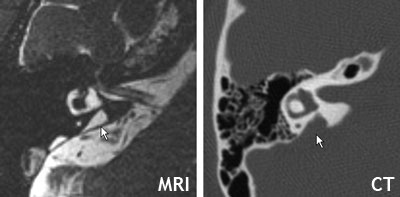More About Childhood Hearing Loss and EVA
Hearing loss in childhood is not uncommon. Research performed in the United States and Great Britain supports an estimate that 1 to 3 of every 1,000 children will develop a permanent hearing loss in one or both ears by age 9. Whether this hearing loss is mild, moderate, or profound, it affects children's ability to participate in daily activities.
Childhood hearing loss has many causes. In the U.S., researchers believe that 50–60% of cases are due to genetic causes, and 40–50% of cases result from environmental causes. Health care professionals use different clues to help them determine the cause of an individual's hearing loss.
Two tests that are often used to identify the cause of hearing loss are magnetic resonance imaging (MRI) and computed tomography (CT) imaging of a person's inner ear. One or both tests are often recommended to evaluate a child with a sensorineural hearing loss—hearing loss caused by damage to the sensory cells and/or nerve fibers of the inner ear. This is particularly true when a child's hearing loss had a sudden onset, is asymmetric (greater in one ear than the other), or progresses or fluctuates.

Images of the right temporal bone of the same individual. Left: MRI scan showing enlargement of the endolymphatic sac and duct (indicated by the arrow). Right: CT scan showing enlargement of the vestibular aqueduct (indicated by the arrow).
The most common finding on the CT scans of children with hearing loss is enlarged vestibular aqueducts, or EVA. (Some people call them dilated vestibular aqueducts, and some call them large vestibular aqueducts. All of these terms mean the same thing.) Research suggests that 5–15% of children with sensorineural hearing loss have EVA.